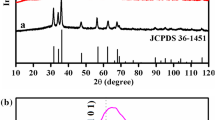Abstract
Hexagonal Al-doped zinc oxide (ZnO) powders with a nominal composition of Zn1−x Al x O (0⩽x⩽0.028) were synthesized by the co-precipitation method. The contents of the Al element in the samples were measured by the inductively coupled plasma-optical emission spectroscopy (ICP-OES) technique. The structures of the Zn1−x Al x O (0⩽x⩽0.028) compounds calcined at 1000 and 1200°C have been determined using the Rietveld full-profile analysis method. Rietveld refinements of the diffraction data indicated that the addition of Al initially has a considerably positive effect on the decreasing of the lattice parameters a and c of Zn1−x Al x O, but the effect becomes very slight and even negative with the further increase of the Al content. The solid solubility limit of Al in ZnO (mole fraction y) is 2.2l%, resulting in Zn0.978Al0.22O. It seems that when the Al content is excessive, Al prefers to form a ZnAl2O4 compound with ZnO, but not to incorporate into the ZnO lattice to occupy the Zn2+ cites. Two phases, [ZnO] (or Al-doped ZnO) and [ZnAl2O4], are obviously segregated in Zn1−x Al x O while the value of x is larger than 0.024. The UV-Vis absorption spectra show that the Al-doped ZnO exhibits a red-shift in the absorption edge without reduced transmission compared with pure ZnO, which also confirms that Al ions enter the ZnO lattice and form a Zn1−x Al x O solid solution.
Similar content being viewed by others
References
Mantas P Q, Baptista J L. The barrier height formation in ZnO varistors. J Eur Ceram Soc, 1995, 15(7): 605–615
Van de Pol F C M, Blom F R, Popma Th J A. R. f. planar magnetron sputtered ZnO films I: Structural properties. Thin Sol Fi, 1991, 204(2): 349–364
Mayo M J. Processing of nanocrystalline ceramics from ultrafine powders. Int Mater Rev, 1996, 41(3): 85–115
Yamamoto T, Yoshida H K. Solution using a codoping method to unipolarity for the fabrication of p-type ZnO. Jpn J Appl Phys, 1999, 38: L166–L168
Kakazey M G, Melnikova V A, Sreckovic T S, Tomila T V, Ristic M M. Evolution of the microstructure of disperse zinc-oxide during tribophysical activation. J Mater Sci, 1999, 34(7): 1691–1697
Kim J, Kimura T, Yamguchi T. Sintering of Sb2O3-doped ZnO. J Mater Sci, 1989, 24(1): 213–219
Zeng D W, Xie C S, Zhu B L, Song W L, Wang A H. Synthesis and characteristics of Sb-doped ZnO nanoparticles. Mater Sci Eng B, 2003, 104: 68–72
Yamazaki T, Yamada H, Watanabe K, Mitsuishi K, Toda Y, Furuya K, Hashimoto I. Nanoparticles in interlayers of Bi2O3-doped ZnO ceramics. Surf Sci, 2005, 25(9): 1675–1680
Han J P, Senos A M R, Mantas P Q. Nonisothermal sintering of Mn doped ZnO. J Eur Ceram Soc, 1999, 19: 1003–1006
Jeong W J, Kim S K, Park G C. Preparation and characteristic of ZnO thin film with high and low resistivity for an application of solar cell. Thin Sol Fi, 2006, 506/507: 180–183
Cai K F, Müller E, Drašar C, Mrotzek A. Preparation and thermoelectric properties of Al-doped ZnO ceramics. Mater Sci Eng B, 2003, 104: 45–48
Ning Z Y, Cheng S H, Ge S B, Chao Y, Gang Z Q, Zhang Y X, Liu Z G. Preparation and characterization of ZnO:Al films by pulsed laser deposition. Thin Sol Fi, 1997, 307: 50–53
Postava K, Sueki H, Aoyama M, Yamaguchi T, Murakami K, Igasaki Y. Doping effects on optical properties of epitaxial ZnO layers determined by spectroscopic ellipsometry. Appl Surf Sci, 2001, 175/176: 543–548
Chen M, Pei Z L, Sun C, Wen L S, Wang W. Surface characterization of transparent conductive oxide Al-doped ZnO films. J Cryst Gr, 2000, 220(3): 254–262
Rodriguez-Carjaval J. An Introduction to the Program FULLPROF2000, Version July 2001, France
Ihara T, Miyoshi M, Iriyama Y, Matsumoto O, Sugihara S. Visible-light-active titanium oxide photocatalyst realized by an oxygen-deficient structure and by nitrogen doping. Appl Catalysis B: Environmental. 2003, 42(4): 403–409
Ihara T, Miyoshi M, Ando M, Sugihara S, Iriyama Y. Preparation of a visible-light-active TiO2 photocatalyst by RF plasma treatment. J Mate Sci, 2001, 36(17): 4201–4207
Author information
Authors and Affiliations
Corresponding author
Additional information
Supported by the Chinese 863 Project (Grant No. 2003AA32X230), Guizhou Provincial Governor Foundation (No. 200673), Guizhou Province Technological Breakthroughs Fund (No.20073011) and Guizhou High-Level Talent Foundation (No. TZJF-2007-57)
Rights and permissions
About this article
Cite this article
Nie, D., Xue, T., Zhang, Y. et al. Synthesis and structure analysis of aluminum doped zinc oxide powders. Sci. China Ser. B-Chem. 51, 823–828 (2008). https://doi.org/10.1007/s11426-008-0061-0
Received:
Accepted:
Published:
Issue Date:
DOI: https://doi.org/10.1007/s11426-008-0061-0




